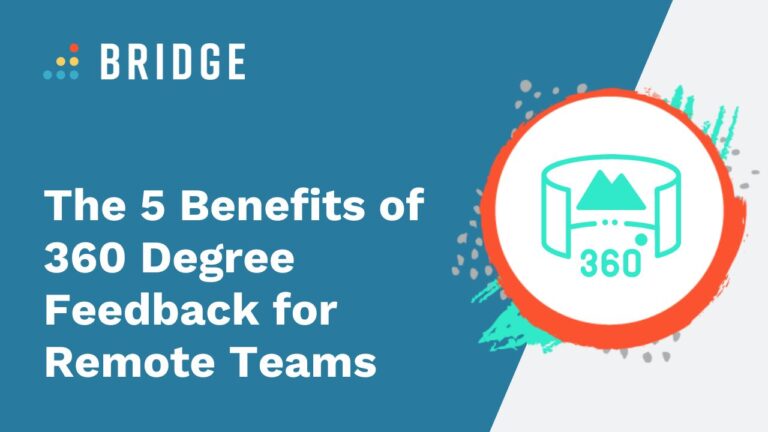At Bridge, we really, really believe in the power of using learning to drive performance. It’s what we do. As part of that, we know that learning comes in a myriad of ways and that performance can be measured in just as many.
We’re big fans of 360 degree feedback. It’s great for the individual employee as it gives them insight that a standard annual performance review doesn’t. It helps the manager out too, because it gives them some eyes and ears on the ground with a multi-dimensional impression of the individual in action. But what’s often overlooked is the enormous benefit of 360° feedback for teams, and specifically, remote teams which are naturally harder to pull together.
Why Do Remote Teams Benefit from 360 Feedback?
Communication on rocket fuel
Remote team work has multiple hurdles to scale when it comes to communication. There’s no leaning back in your chair and making a comment, or asking a question of a co-worker with just the right tone of voice.
With remote teams, communication can become painfully formal in a way that also makes those hurdles higher.
With 360 degree feedback, employees are given the opportunity to share feedback in a constructive, but anonymous way. Difficulties are flagged and concerns are ironed out.
Of course, to make this really work, the feedback insights should be used as a springboard for conversation.
Team effectiveness is boosted
How does self-evaluation and individual appraisal of a co-worker increase the effectiveness of the team? Well, remote teams can easily become silos of individuals. However, with the insight from 360° feedback, it’s possible to break down these silos by seeing where individual strengths and weaknesses lie and linking them together. Blind spots are eliminated and the team can become more productive and effective by knowing how each individual contributes to the whole.
The individual also benefits from understanding how they contribute to the team’s performance, allowing them to further strengthen their team-working capability.
For this to work, employee appraisal questions should be shaped around the specific objectives of the team.
The sum of the whole is greater than the sum of the parts
We love the synergy created by 360 degree feedback. We find that teams that use self-appraisal, feedback from co-workers, and things like a mid-year review by management, have much more collaborative teams. They simply get more done to a higher standard.
This is because the individual players in the team become more cohesive, and their skills and goals become aligned. Individuals can see their real value to the team and build on their contribution. With clear understanding of where strengths lie in individuals, they can be capitalised on as strengths for the team as a whole.
A developing team
We want our teams to suit the business objectives of the future and not just today. For this to happen, we need to uncover the areas for improvement and step in to deliver development solutions.
360° feedback doesn’t just identify training and development needs in individuals. It identifies training and development needs in the team. If a whole team is lacking particular skills, you are building a skills gap which can cause real problems in the future. A multi-dimensional approach to feedback uncovers this and gives you time to address it in a way that standard performance management and annual appraisals typically don’t.
It drives engagement
When 360 degree feedback isn’t just a matter of the occasional staff appraisal, but integrated into everyday life of the remote team, it makes for more motivated and engaged employees.
For example, if the LMS + Performance Management platform that your teams communicate through is Bridge, co-workers can leave morale-boosting comments of praise. By peers celebrating their successes, especially in a way that is seen by others within the line management, the individuals become more engaged in the success of the team itself.
It has the side benefit of making everyone feel more connected too.




